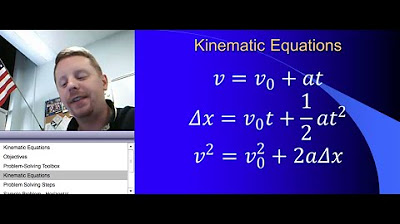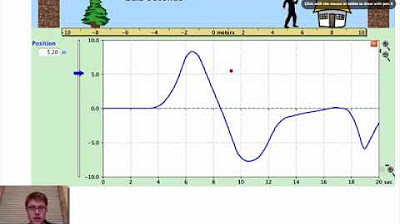Constant Acceleration Problems
TLDRThe video script presents a comprehensive guide to solving constant acceleration problems, emphasizing the importance of understanding how velocity changes uniformly when acceleration is constant. It walks through a specific problem involving a cyclist decelerating to a stop, explaining the need to account for the direction of velocity and acceleration. The script clearly outlines the steps to find the time taken and the displacement during deceleration, using the appropriate equations and emphasizing the significance of maintaining the correct number of significant figures in the calculations.
Takeaways
- 📚 The lesson is about solving constant acceleration problems, where acceleration (a) remains unchanged.
- 🔄 Constant acceleration means the velocity changes by the same amount every second, represented as a = Δv/Δt.
- 🌟 There are four equations of constant acceleration, but only one applies when dealing with constant velocity and a single velocity value.
- 🚴 Problem-solving involves identifying the given quantities: initial velocity (VI), final velocity (VF), acceleration (a), displacement (ΔX), and time (t).
- 🎯 The problem presented involves a cyclist decelerating from an initial speed of 9.12 m/s to a final speed of 0 m/s with an acceleration of 0.86 m/s².
- 🧭 The direction of acceleration is positive, indicating the cyclist is accelerating to the right, but is initially moving to the left.
- ⏱️ Time (t) is the unknown in the problem, and the first equation with all four knowns except time is used to solve for it.
- 🤔 A negative time result indicates an error in sign convention; the initial velocity should be negative if the final velocity is zero and acceleration is positive.
- 📊 Displacement (ΔX) is calculated using the equation ΔX = 1/2(VI + VF) ⋅ t with the known values.
- 🔢 The calculated displacement is negative, which makes sense as the cyclist is moving in the opposite direction to the acceleration, resulting in a value of -48.4 meters.
- 📌 All values, including the final answer, are rounded to three significant figures to maintain consistency with the given data.
Q & A
What does constant acceleration imply in terms of velocity?
-Constant acceleration implies that the velocity changes by the same amount every second. When the acceleration is constant, the change in velocity per second is the same.
What are the four equations of constant acceleration?
-The four equations of constant acceleration are used to describe the motion of an object when its acceleration is constant. These equations relate the initial velocity (VI), final velocity (VF), acceleration (a), displacement (ΔX), and time (t) of the object.
How can you determine if an equation applies to constant acceleration?
-An equation applies to constant acceleration if it includes terms for initial velocity, final velocity, acceleration, and either displacement or time. If only one velocity is given without specifying if it's initial or final, the equation does not apply to constant acceleration.
What are the five quantities involved in constant acceleration problems?
-The five quantities involved in constant acceleration problems are initial velocity, final velocity, acceleration, displacement, and time.
How do you approach a problem where an object is coming to a complete stop?
-In a problem where an object is coming to a complete stop, the final velocity (VF) is zero. You need to consider the direction of the initial velocity and acceleration to determine their signs, which will help you solve for the time and displacement.
What is the significance of the unit meters per second squared in the context of acceleration?
-The unit meters per second squared (m/s^2) indicates the rate of change of velocity per second. It means that for each second that passes, the velocity of the object changes by the given number of meters per second.
Why can't time be negative in a physical context like motion problems?
-Time cannot be negative because it does not make physical sense. Negative time would imply moving backward through the process, which is not possible in real-world scenarios. Time always moves forward, and thus, any calculations involving time should result in positive values.
How do you handle the direction of velocities in solving problems?
-The direction of velocities must be considered, especially when dealing with problems involving acceleration and deceleration. You assign positive or negative signs to velocities based on the chosen coordinate system. If the acceleration is opposite to the direction of the initial velocity, it indicates deceleration, and the initial velocity should have an opposite sign to the acceleration.
What is the formula for displacement in terms of constant acceleration and how is it used?
-The formula for displacement in terms of constant acceleration is ΔX = (1/2) * (VI + VF) * t. It is used when you have the initial velocity (VI), final velocity (VF), and time (t) to find the displacement (ΔX) of the object during the time interval.
How do you ensure your answers have the correct number of significant figures?
-To ensure your answers have the correct number of significant figures, you should match the number of significant figures in your answer to the number of significant figures in your given values. If all given values have three significant figures, your calculated answer should also have three significant figures.
What is the significance of the negative displacement calculated in the script?
-The negative displacement indicates that the object has moved in the opposite direction to the chosen positive direction of the coordinate system. In the context of the script, it suggests that the cyclist was initially moving in the negative direction and came to a stop, which is consistent with the problem statement.
Outlines
📚 Introduction to Constant Acceleration Problems
This paragraph introduces the concept of constant acceleration problems, emphasizing that when acceleration is constant, the velocity changes by the same amount every second. It explains that there are four equations for constant acceleration, which are applicable when acceleration is present. The discussion revolves around the given problem of a cyclist coming to a stop from an initial speed, highlighting the need to identify initial velocity (VI), final velocity (VF), acceleration (a), displacement (ΔX), and time (t) as the key quantities involved. The paragraph also touches on the directionality of these quantities and the implications for the calculations, such as the negative sign indicating opposite directions of velocity and acceleration.
🧮 Solving for Time and Displacement in Constant Acceleration
This paragraph delves into the process of solving for time and displacement in a constant acceleration scenario. It starts by identifying the correct equation that includes the given quantities (acceleration, initial velocity, final velocity, and time) and solving for the unknown (time). The paragraph discusses the calculation of time, highlighting the initial confusion due to the negative result and the realization that the initial velocity must have been negative. The second part of the paragraph focuses on calculating the cyclist's displacement (ΔX) during the stopping process. It explains the selection of the appropriate equation, the substitution of known values, and the importance of maintaining significant figures in the final answer. The paragraph concludes with the calculation of a negative displacement, indicating the cyclist's movement in the opposite direction to the initial velocity.
Mindmap
Keywords
💡constant acceleration
💡initial velocity (VI)
💡final velocity (VF)
💡acceleration (a)
💡displacement (ΔX)
💡time (T)
💡kinematic equations
💡deceleration
💡negative sign
💡significant figures
💡direction
Highlights
The lesson focuses on solving constant acceleration problems, where the value of acceleration (a) remains unchanged.
When acceleration is constant, velocity changes by the same amount every second, indicating a linear relationship between velocity and time.
There are four equations of constant acceleration, which are essential for understanding the dynamics of motion under constant acceleration.
The problem at hand involves a cyclist decelerating to a stop, which means the final velocity is zero, and the initial velocity is given as 9.12 m/s.
The acceleration value is given as 0.86 m/s^2, indicating the rate of change of velocity per second.
The direction of the acceleration is positive, which initially causes confusion as the cyclist is slowing down, suggesting a negative direction for the initial velocity.
The key equation used to solve for time (T) involves rearranging the constant acceleration formula to isolate T, and substituting the known values for initial velocity, final velocity, and acceleration.
A mistake in the initial setup leads to a negative time solution, which is corrected by realizing that the initial velocity must be negative, as the cyclist is decelerating.
Once the correct signs are applied, the time calculation yields a positive value, which is physically meaningful in the context of the problem.
The second part of the problem involves calculating the cyclist's displacement during the deceleration, which is found using a different equation from the constant acceleration set.
Displacement (ΔX) is calculated using the formula ΔX = (1/2) * (VI + VF) * T, where VI is the initial velocity, VF is the final velocity, and T is the time.
The calculated displacement is negative, which indicates the cyclist's change in position in the opposite direction to the initial velocity.
The problem emphasizes the importance of understanding the signs of velocities and accelerations in relation to the direction of motion.
The use of significant figures in the given data and the final answers is crucial for maintaining the accuracy and precision of the calculations.
The lesson demonstrates the practical application of physics principles in solving real-world problems, such as the motion of a cyclist.
The process of solving these problems involves critical thinking and the ability to correct mistakes, ensuring that the final answers are physically plausible.
Transcripts
Browse More Related Video

High School Physics: Kinematic Equations

How to match motion graphs in physics (more examples)

Deriving Kinematic Equations - Kinematics - Physics

01 - Motion with Constant Acceleration in Physics (Constant Acceleration Equations)

Choosing kinematic equations | One-dimensional motion | AP Physics 1 | Khan Academy

Position vs. Time Graph - Part 2
5.0 / 5 (0 votes)
Thanks for rating: